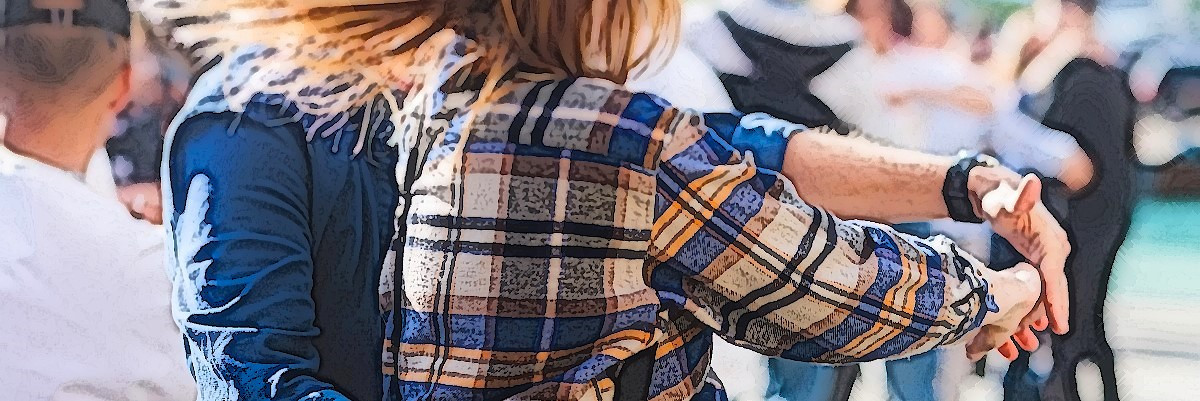I’ll confess straight away: dancing isn’t my forte. You won’t find me on the dance floor at parties, weddings, or anywhere else. The idea of dancing, especially in front of others, fills me with a particular brand of dread. Despite well-meaning assurances that I’d enjoy myself if I just gave it a try, my teenage experiences at school dances were less than fun. The relentless social pressure to participate, to must dance, only solidified my preference for observing from the sidelines. I genuinely appreciate watching others revel in dance; it looks enjoyable, and I’m glad they find joy in it. However, for me, participation feels… different. Perhaps it’s the self-consciousness that takes over, the imagined spectacle of flailing limbs and off-rhythm movements, a disconnect between my internal sense of rhythm and external execution. It’s an acutely uncomfortable feeling, like being trapped in a spectator’s view of my own awkwardness.
 Two people square dancing – two
Two people square dancing – two
However, while I may not dance myself, I deeply appreciate the art and joy of dance, especially when others embrace it. Weddings, for instance, offer a fascinating spectrum of dance abilities. Children often move with an uninhibited natural grace. Some adults compensate for a lack of technical skill with infectious enthusiasm. And then there are those whose expressions while dancing I find both amusing and slightly cringeworthy, a silent worry that I might mirror that very look if I were to join in. Of course, in the spirit of celebration, no one else likely notices or judges; it’s simply people having fun. But that hyper-awareness of self persists.
The formal first dances at weddings, often practiced and polished, are particularly touching. They become a visible symbol of the couple’s commitment, their shared effort a beautiful expression of new love. Even the less polished dances, where couples sway awkwardly, unsure of steps, yet clinging to each other, are equally endearing. They embody the essence of partnership, a willingness to navigate the unknown together, even without clear direction. It’s a beautiful, if sometimes unintentionally prolonged, display of trust and unity, even if the DJ occasionally needs to intervene to shorten the song. These formal dances often communicate love and connection more effectively than words ever could.
This observation leads me to a question: would my own perception of dance be different if formal dance had been more emphasized in my youth? The typical high school dance, often devolving into a chaotic mix of unstructured movements set to thumping bass and random slow dances, never appealed to me. Imagine if, instead, my teenage years had included lessons in swing dance, ballroom etiquette, or the structured elegance of English country dancing. Perhaps I would have developed not only a greater appreciation for dance but also the confidence and competence to participate. Instead of seeking the nearest exit at prom, maybe I would have actually stayed and enjoyed the evening.
For me, overcoming self-consciousness in any activity hinges on understanding the rules and expectations. I recall struggling with spontaneous prayer, constantly preoccupied with formulating the next words. Discovering the structured prayers of the Church was liberating, allowing me to truly connect with prayer for the first time. Similarly, the structured order of a formal liturgy, a slow and solemn dance in itself, is comforting. Rules and etiquette, in liturgy or dance, can paradoxically set participants free from anxiety and self-doubt.
This is why the growing movement to introduce formal dance to teenagers is so compelling. The Chesterton Academy of St. Louis, where I serve as chaplain, initiated swing dance lessons for all students last year. A local homeschool cooperative followed suit. Several parishes, including my own Oratory of Sts. Gregory and Augustine, hosted English country dance events where teenagers learned and practiced together. The results were remarkable. Suddenly, dances became popular social events, eagerly anticipated by teenagers throughout the community.
The structured learning of formal dance steps fostered natural and healthy interactions between young men and women. Teenagers’ self-confidence visibly increased. Equipped with the knowledge of dance steps and social etiquette, young men felt empowered to ask young women to dance, and these invitations were graciously accepted. The typical awkwardness often associated with teenage social interactions seemed to melt away. Witnessing even the most hesitant students embrace dance and gain confidence was truly inspiring.
Anna Kalinowski, who instructed our Oratory teens in English country dancing, perfectly captured this phenomenon: “I often observe a visible sense of relief in my shy or reserved students when they realize that formal dance styles like English country or ballroom dance possess a structure they can rely on. Adhering to this form allows even novice dancers to achieve a degree of grace, liberating them from the crippling self-consciousness that arises in unstructured, modern dances – often perceived as chaotic and embarrassing displays.” Her insightful observation perfectly mirrored what we witnessed firsthand.
The impact of teaching teenagers to dance extended far beyond simply acquiring dance skills. These young people gained self-confidence, developed crucial social interaction skills, enhanced their courtesy and social ease, and, importantly, had a lot of fun. I wholeheartedly recommend that every school and community consider implementing similar initiatives.
While my own dancing days may have passed, it’s certainly not too late for the next generation. Don’t repeat my mistake. Encourage dance education for teenagers. By learning to dance, and embracing the joy of movement and connection, they can unlock a world of benefits that extend far beyond the dance floor.

